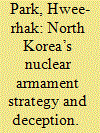| Srl | Item |
| 1 |
ID:
189875


|
|
|
|
|
| Summary/Abstract |
This article introduces the ‘deterrence failure’ concept and applies it to North Korea’s nuclear threat situation. For this purpose, it selects five factors, including retaliation posture; credibility of retaliation; probability of the challenger’s success; challenger’s irrational leader; and situational desperateness, to evaluate the US–South Korea nuclear deterrence posture against North Korea. Except for the retaliation posture, most factors are very concerning. Therefore, to strengthen their deterrence posture against North Korea, the United States and South Korea should take a few practical measures to ensure the implementation of the US extended deterrence, including the forward-deployment of more US retaliation assets around the Korean Peninsula.
|
|
|
|
|
|
|
|
|
|
|
|
|
|
|
|
| 2 |
ID:
190105


|
|
|
|
|
| Summary/Abstract |
This article analyzes North Korea’s nuclear armament strategy. For this purpose, it applies Vipin Narang’s theory to North Korea and analyzes North Korea’s efforts to develop and strengthen its nuclear weapons on a strategic level. This study argues that North Korea’s deception operations were crucial to the ultimate success of its “strategic” nuclear buildup. This article found that North Korea initially employed a “hiding strategy,” but after its nuclear program was exposed, it managed to continue its nuclear program through deceptive agreements with the United States and eventually succeeded in developing nuclear weapons in 2013. Then, North Korea adopted a “sprinting strategy” and initiated deceptive denuclearization negotiations with the United States to prevent a military strike by the United States and gain the time necessary for its continuous nuclear buildup. China also allowed a “sheltered pursuit” through tolerance of North Korea’s nuclear armament and diplomatic assistance as well as various clandestine assistances.
|
|
|
|
|
|
|
|
|
|
|
|
|
|
|
|
| 3 |
ID:
193526


|
|
|
|
|
| Summary/Abstract |
As North Korea succeeds in developing hydrogen bombs, ICBMs, and SLBMs capable of destroying U.S. cities, the current U.S. extended deterrence may not work. The United States must empower South Korea with a nuclear option to exercise its right of self-defense by prescribing an on-site nuclear balance. This article presents and compares two options for the United States: (1) South Korea’s nuclear armament and (2) another nuclear sharing system in Northeast Asia. As a result, this article recommends the second option with sea-borne sharing and incremental implementation.
|
|
|
|
|
|
|
|
|
|
|
|
|
|
|
|